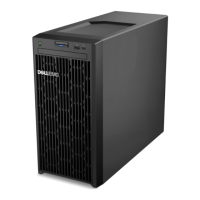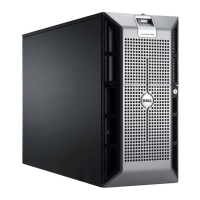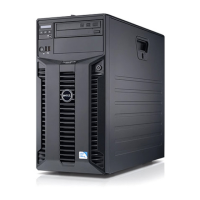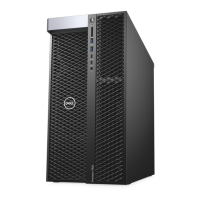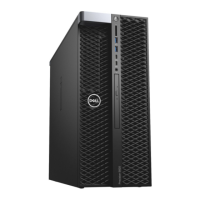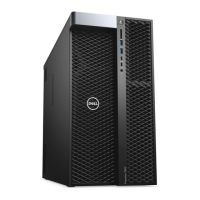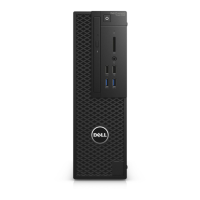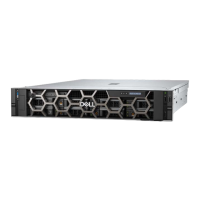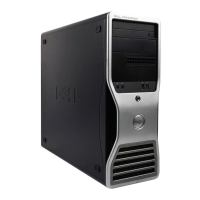Do you have a question about the Dell PowerEdge T320 Series and is the answer not in the manual?
Details the features and indicators on the front panel of the system in tower mode.
Details the features and indicators on the front panel of the system in rack mode.
Explains the functionality and indicators of the system's LCD panel.
Describes system conditions and corrective actions associated with front panel diagnostic indicators.
Details the features and indicators located on the back panel of the system.
Provides a guide to understanding the indicator lights on the Network Interface Card (NIC).
Explains the status indicator lights for both redundant and non-redundant AC power supplies.
Step-by-step procedure to access and enter the system's BIOS setup utility.
Overview of the main menu and various screens available within the System Setup.
Configuration options and information related to the system's installed memory.
Configuration options and information related to the system's processors.
Options for configuring system security features like passwords and TPM.
Information on creating and using system and setup passwords for security.
Interface for configuring iDRAC parameters using UEFI.
Instructions for installing or removing the optional front bezel.
Details on the system feet used for stability in tower mode.
Safety precautions and procedures for opening and closing the system cover.
Details on supported optical and tape drive configurations and installation.
Information on supported hot-swappable hard drive configurations and installation.
Information on supported cabled hard drive configurations and installation.
Information on system memory support, types, and specifications.
Information on supported processors and procedures for replacement or upgrade.
Information on supported redundant AC power supplies and their configurations.
Information on the supported non-redundant AC power supply.
Information on the system battery and its replacement.
Overview of the control-panel assembly components.
Information on installing and configuring expansion cards.
Safety precautions relevant to rack installation.
Steps and items required to prepare the system for rack conversion.
Reference to the Rack Installation Guide for detailed rack mounting procedures.
Important safety warnings and precautions before troubleshooting.
Steps to diagnose and resolve issues preventing the system from starting.
Steps to diagnose and resolve problems with the video output.
Steps to troubleshoot issues with USB devices like keyboards and mice.
Steps to diagnose and resolve issues with the Network Interface Card (NIC).
Steps to diagnose and resolve issues with power supplies.
Steps to diagnose and resolve issues with system memory modules.
Steps to diagnose and resolve issues with hard drives, including RAID configurations.
Steps to diagnose and resolve issues related to the system processor.
Information about Dell's online diagnostic tools for system testing.
Information about the built-in ePSA diagnostics for pre-boot system assessment.
Steps to launch and run the embedded system diagnostics program.
Details the function and settings of various system board jumpers.
Identifies and describes the connectors on the system board.
Procedure to disable or clear system and setup passwords using a jumper.
Specifications related to the system's processor type.
Specifications for system memory, including architecture, capacities, and minimum RAM.
Specifications for hard drives, optical drives, and tape drives.
Lists and describes the system's connectors (back, front, internal).
Environmental specifications, including temperature, humidity, vibration, and altitude.
Details on brief text messages displayed on the system's LCD.
Explanations of system error messages and recommended actions.
Alerts about potential problems, requiring user response before task continuation.
Messages issued by system diagnostic utilities during tests.
Alerts generated by management software for system status, warnings, and failures.
Procedures for contacting Dell for sales, technical support, or customer service.
Details the features and indicators on the front panel of the system in tower mode.
Details the features and indicators on the front panel of the system in rack mode.
Explains the functionality and indicators of the system's LCD panel.
Describes system conditions and corrective actions associated with front panel diagnostic indicators.
Details the features and indicators located on the back panel of the system.
Provides a guide to understanding the indicator lights on the Network Interface Card (NIC).
Explains the status indicator lights for both redundant and non-redundant AC power supplies.
Step-by-step procedure to access and enter the system's BIOS setup utility.
Overview of the main menu and various screens available within the System Setup.
Configuration options and information related to the system's installed memory.
Configuration options and information related to the system's processors.
Options for configuring system security features like passwords and TPM.
Information on creating and using system and setup passwords for security.
Interface for configuring iDRAC parameters using UEFI.
Instructions for installing or removing the optional front bezel.
Details on the system feet used for stability in tower mode.
Safety precautions and procedures for opening and closing the system cover.
Details on supported optical and tape drive configurations and installation.
Information on supported hot-swappable hard drive configurations and installation.
Information on supported cabled hard drive configurations and installation.
Information on system memory support, types, and specifications.
Information on supported processors and procedures for replacement or upgrade.
Information on supported redundant AC power supplies and their configurations.
Information on the supported non-redundant AC power supply.
Information on the system battery and its replacement.
Overview of the control-panel assembly components.
Information on installing and configuring expansion cards.
Safety precautions relevant to rack installation.
Steps and items required to prepare the system for rack conversion.
Reference to the Rack Installation Guide for detailed rack mounting procedures.
Important safety warnings and precautions before troubleshooting.
Steps to diagnose and resolve issues preventing the system from starting.
Steps to diagnose and resolve problems with the video output.
Steps to troubleshoot issues with USB devices like keyboards and mice.
Steps to diagnose and resolve issues with the Network Interface Card (NIC).
Steps to diagnose and resolve issues with power supplies.
Steps to diagnose and resolve issues with system memory modules.
Steps to diagnose and resolve issues with hard drives, including RAID configurations.
Steps to diagnose and resolve issues related to the system processor.
Information about Dell's online diagnostic tools for system testing.
Information about the built-in ePSA diagnostics for pre-boot system assessment.
Steps to launch and run the embedded system diagnostics program.
Details the function and settings of various system board jumpers.
Identifies and describes the connectors on the system board.
Procedure to disable or clear system and setup passwords using a jumper.
Specifications related to the system's processor type.
Specifications for system memory, including architecture, capacities, and minimum RAM.
Specifications for hard drives, optical drives, and tape drives.
Lists and describes the system's connectors (back, front, internal).
Environmental specifications, including temperature, humidity, vibration, and altitude.
Details on brief text messages displayed on the system's LCD.
Explanations of system error messages and recommended actions.
Alerts about potential problems, requiring user response before task continuation.
Messages issued by system diagnostic utilities during tests.
Alerts generated by management software for system status, warnings, and failures.
Procedures for contacting Dell for sales, technical support, or customer service.
| Form Factor | Tower |
|---|---|
| Chipset | Intel C600 series |
| Storage | Supports HDDs and SSDs |
| RAID Controller | PERC H310, H710, H710P |
| Power Supply | 350W |
| Network Controller | Broadcom 5720 dual-port 1GbE LOM |
| Drive Bays | Up to 8 x 3.5" or 16 x 2.5" |
| Operating System Support | Red Hat Enterprise Linux, SUSE Linux Enterprise Server, VMware ESXi |
| Processor | Intel Xeon E5-2400 series, up to 6 cores |
